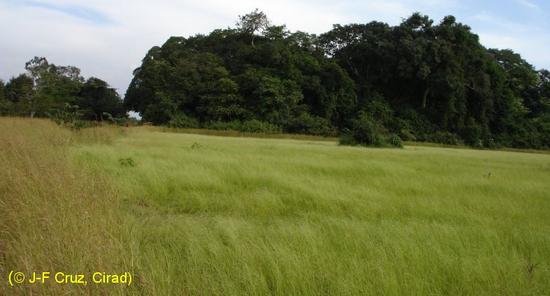Cultivation
Climate
Fonio is grown in tropical climates with a marked dry season, average temperatures of 25 to 30°C and between 900 and 1000 mm of rainfall. However, in Guinea, it is also produced in highland areas (over 1000 m above sea level), where temperatures are cooler, and in zones with either low or high rainfall.
Soils
Fonio is not generally grown in rotation systems, and is planted on light (sandy to stony) soils. It is not very demanding, and can cope with poor soils or marginal areas, particularly in the case of late varieties. Richer soils are used for early varieties. Nevertheless, fonio can be grown in rotation systems, in which case it often follows on from rice, millet, sorghum or groundnut. On small areas, ploughing is done manually with a daba (traditional hoe) while on larger plots, ploughing with an animal-drawn plough tends to increase.
.
Fonio plants (© J-F Cruz, Cirad)
Fonio field in Guinea (© J-F Cruz, Cirad)
Sowing and upkeep
Even now, fonio is primarily planted and maintained by hand. With the first rains, the seeds are broadcast-sown on superficially loosened soil, at a rate of 10 to 30 kg of seed/ha. Some farmers sow more densely (> 50 kg/ha), to reduce competition from weeds at the time of emergence.
The seeds are lightly dug in by harrowing or covered with a daba (hoe). They germinate rapidly, and the crop subsequently only requires one or two hoeing rounds.
Broadcast sowing of fonio (© T. Meudic)



